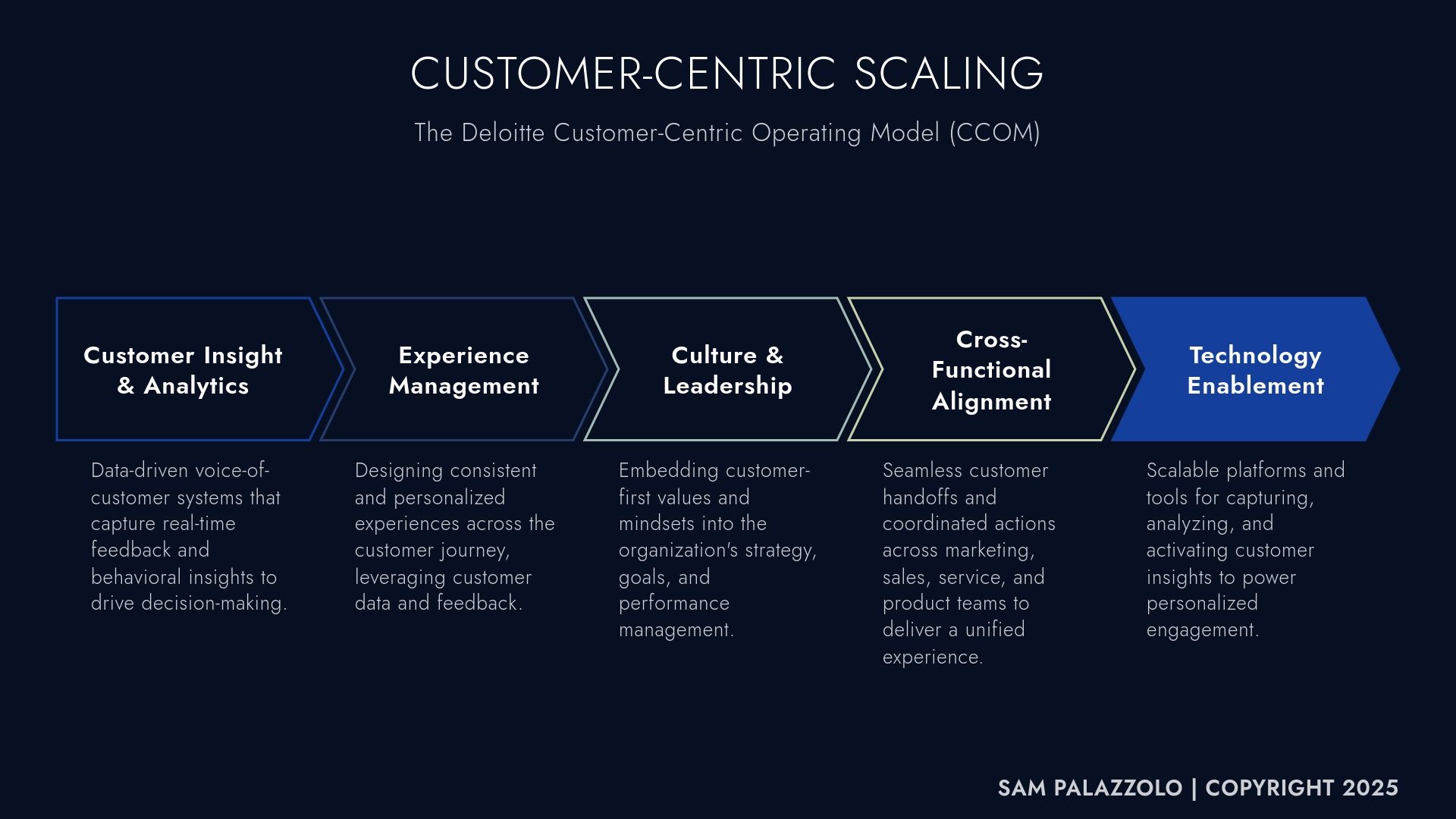Customer-Centric Scaling: Why Listening Is The New Growth Strategy
Jul 21, 2025
As businesses scale, a quiet but dangerous shift often occurs: the voice of the customer gets drowned out. In the pursuit of growth—new markets, new hires, new technologies—many organizations unintentionally replace customer intimacy with operational efficiency.
The impact is measurable. According to Bain & Company, 80% of CEOs believe they offer a superior customer experience, yet only 8% of their customers agree. Harvard Business Review data shows that a mere 5% increase in customer retention can boost profits by up to 95%. Meanwhile, PwC reports that customer-first companies outperform competitors by 80% in revenue growth.
Clearly, customer-centricity is not a soft differentiator—it’s a scaling prerequisite. But how do you maintain or deepen customer alignment while expanding rapidly? The answer lies in transforming customer focus from a front-line activity into a system-wide operating model.
The Hidden Risk of Growth Without Customer Focus
In the early stages, most companies are inherently customer-centric. Founders speak directly to users, sales and product teams huddle daily to resolve feedback, and customer support has a direct line to decision-makers. But as scale sets in, complexity increases and silos emerge.
Customer needs become generalized. Support tickets are triaged, not analyzed. Product roadmaps chase internal efficiency over user experience. Eventually, the organization no longer builds for customers—it builds for itself.
This erosion doesn’t happen all at once, but its effects are profound: rising churn, declining Net Promoter Scores, stagnant LTV. What’s worse, these symptoms often appear just as revenue begins to spike—leading leaders to misattribute success to systems rather than customer resonance.
Scaling with Customer-Centric Operating Models
To scale without sacrificing customer connection, companies must intentionally architect their operating models around customer insight. One of the most effective blueprints is the Customer-Centric Operating Model (CCOM) developed by Deloitte. It reframes customer-centricity from a tactical initiative into a strategic infrastructure.
Five Pillars of the Customer-Centric Operating Model
1. Customer Insight & Analytics
Customer-centric scaling begins with data—but not just any data. This pillar focuses on systematizing customer feedback across all touchpoints: onboarding, support, retention, and expansion. From surveys and usage data to social listening and win/loss analysis, organizations must build real-time insight engines that fuel decision-making.
Key Action: Create a centralized voice-of-customer dashboard visible to all departments, not just support or CX teams.
2. Experience Management
Experience consistency is critical as customer journeys scale. Organizations must deliberately design processes that minimize friction and personalize high-value moments. At scale, this requires balancing automation with authenticity.
Key Action: Conduct journey mapping exercises quarterly to identify and optimize high-impact moments—especially during onboarding and renewal phases.
3. Culture & Leadership
Customer-centricity must be driven from the top. It cannot be delegated to a single department. Embedding this pillar into your leadership culture means tying customer outcomes to executive KPIs, performance reviews, and hiring criteria.
Key Action: Make “customer obsession” a core leadership competency—promote and reward behavior that reinforces it.
4. Cross-Functional Alignment
Scaling often introduces functional silos. Marketing generates demand, sales closes deals, operations deliver, and customer success reacts. A customer-centric model breaks down these silos by aligning teams on shared customer outcomes.
Key Action: Implement cross-department stand-ups focused solely on customer signals and trends—not internal updates.
5. Technology Enablement
The tech stack must enable—not replace—customer relationships. CRMs, feedback tools, predictive analytics, and support platforms should work together to surface, analyze, and act on customer insights at scale.
Key Action: Audit current tools for feedback redundancy and integration gaps. Eliminate systems that isolate data instead of enhancing visibility.
Real-World Application: Fixing the Customer Feedback Gap
One tech-enabled services firm we advised had recently crossed the 100-employee mark. Revenues were up, and so were customer support requests—but customer satisfaction scores were trending in the opposite direction.
Digging deeper, we discovered that no unified feedback system existed. Support teams logged issues, but they weren’t escalated. Sales heard complaints during renewals, but they had no process to share them. Product was building based on roadmap assumptions—not real-time usage data.
We applied the CCOM model in three phases:
- Built a feedback repository connecting CRM, ticketing, and product analytics.
- Implemented biweekly cross-functional meetings focused exclusively on customer signals.
- Reframed leadership scorecards to include customer outcomes.
Within one quarter, NPS increased by 14 points, churn dropped 12%, and customer expansion improved. But more importantly, the company began to think—and act—like a customer-led organization again.
Why Customer-Centric Scaling Drives Sustainable Growth
Customer-centric scaling is not about delivering boutique service at scale—it’s about systematizing listening, relevance, and responsiveness. When done right, it delivers more than loyalty. It delivers compound growth, because customers who feel heard are customers who stay, expand, and advocate.
In today’s crowded and commoditized markets, competitive advantage doesn’t come from product features or operational efficiency alone. It comes from how well you understand and serve your customer—especially as you grow.
If your growth strategy lacks a customer-centric foundation, it’s time to rethink your model before churn and irrelevance catch up.
Sam Palazzolo, Principal Officer @ The Javelin Institute
Ready to put your customers back at the center of your scaling strategy?
Sign up for the Business Scaling newsletter at sampalazzolo.com for weekly frameworks, real-world case studies, and strategic insights to scale with precision.
SUBSCRIBE FOR WEEKLY BUSINESS SCALING STRATEGIES
REAL STRATEGIES. REAL SOLUTIONS.
We respect your privacy. Unsubscribe at any time.
